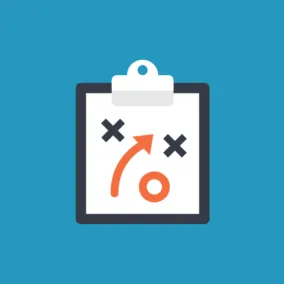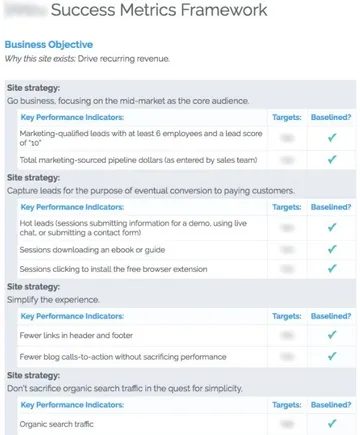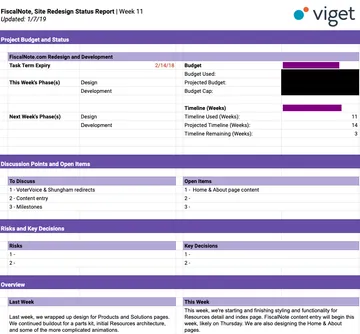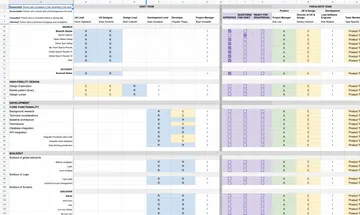Educating Your Clients is a Vital Project Management Skill

Ryan Schaefer, Former Senior Project Manager
Article Categories:
Posted on
A lot of client education means sharing what you know—about the nature of the work, effective project management, and how to ensure smooth processes throughout the project.
Contracts have been signed, teams have been reserved, and budgets have been agreed upon. Now it's time for the fun part to begin: doing the work.
As the Project Manager, it’s up to you to set the course for the entirety of the project. It can be daunting. There are a lot of resources out there to help you be a good PM, but in this blog post, I’m going to cover an often overlooked part of successful project management: educating and training your client, and the value that brings throughout the project lifespan. Hopefully there is information here that is useful to non-PMs as well, especially those within an agency where all team members interface with clients.
Below, I’ve laid out some tips and strategies to help achieve the primary goal of client education: helping their team understand when, why, and how they should contribute to the project. This post is split up into three sections, each with its own set of guidelines and objectives:
- Educating clients about digital work
- Educating clients about the value of collaboration
- Educating clients about approvals and communication
You’ll see that a lot of client education means sharing what you know—about the nature of the work, effective project management, and how to ensure smooth processes throughout the project. Keep this in mind as you’re getting started.
Educating clients about digital work.
Objective: Your client better understands the nature of the work and what goes into each deliverable that will be shared.
Be mindful that clients are experts in their field—and you’re an expert in yours.
It’s intuitive; your client is good at what they do, but most of the time, that’s not software strategy, design, or development. That’s why they hired you.
You can’t expect a client to understand the nuances of everything your team is doing. Years spent coding or designing leaves you susceptible to taking certain things for granted. The concept of a wireframe might be obvious to you, but it’s not the client’s responsibility to know what purpose they serve. Things like this can become a pain point during more resource-heavy projects. If you and your team are unable to clearly articulate your process, decisions, and get your client to the point where they understand the why behind your execution, you’re headed for difficult conversations down the road.
Map everything out beforehand as best you can.
It’s always smart to look for opportunities to build empathy with your client in light of the journey you’re about to take together. Not only will this help depreciate cautious and over-diplomatic communication, but it will streamline feedback, grant you a little extra freedom to make decisions, and hopefully pay dividends down the road.
A good starting point for this is to plan out key activities, milestones, and approval loops within the early weeks of a project kickoff. This is more formally known as a project plan. A thorough project plan will reemphasize that you’re organized, you don’t let details fall through the cracks, and you value open and honest communication. It’s also a good place to set the expectation that some work will fall on your client. They can’t go dormant. Show the client you want them to be involved, or at least aware of what’s happening, every step of the way.
Define success.
Early on, work closely with the client to spell this out. Spend the necessary time and resources on it—it will provide a guidepost for all key decisions, and everything will be in service of that. It will also reinforce the idea that both sides are working collaboratively as one unit.

In essence, you’re looking to agree with your client on what would make this engagement successful, both from an accounts perspective and a product perspective. Can the teams expand the relationship while meeting or exceeding all of the product’s goals?
If these targets are set and all goes well, the client will receive superb work from your team and you’ve found a great long-term partner. It’s a win-win.
Educating clients about collaboration.
Objective: Your client better understands what to expect when working with your team, and how to be part of it.
Know that there’s an equal exchange of services.
Yes, the client is paying you. But in exchange, you’re giving them something equally valuable: the benefit of your expertise.
There are smart ways to position this that allow both parties to conform to a flat hierarchy. Working collaboratively is always better than having your team turn into worker bees who just execute client orders.
Apart from not quite understanding how to get from Point A to a functioning digital property, sometimes clients won’t know exactly what it is they want to achieve in the first place. This is where your established goals and success metrics become valuable. Your team is working to solve business problems for them, not just building something that meets the specs and saying goodbye.
Reinforce the agile manifesto where appropriate.
Even if you’re not using agile principles to guide your project methodology, the implied lessons can be applied in most situations. The four principles are:
- Individuals and interactions over processes and tools
- Working software over comprehensive documentation
- Customer collaboration over contract negotiation
- Responding to change over following a plan
Above everything else, these ideas represent practical approaches to common problems that arise due to time or budget constraints. I’d be very surprised if a client would rather have a giant instruction manual instead of a functioning product. Your goals should align here.
But there are tradeoffs—software development is both an art and a science, and you can only fit in so many features before you’re out of runway. Being nimble and prepared to raise a flag when things start to veer of course is an absolute necessity. If you’ve kept your client aware of your team’s pace and progress, this won’t be a conversation where they feel blindsided.
Help your client make decisions within constraints (budget, time, etc.).
At Viget, we’re big fans of setting up regular touchpoints with our main client contact and the entire client team. The 1:1s with your main point of contact should be focused around budget burn, timeline, blockers, requirements, risks, and questions. In preparation for this, it’s helpful to create a status report documenting all of these.
The status report serves multiple purposes, but most relevant here is that it sets expectations and illustrates the fact that everyone shares budget and timeline responsibility. Continually trying to squeeze in extra features or design changes is a slippery slope. They don’t want a product delivered late or over-budget either. If you’re forthcoming with the reality of the scope and budget status, you’ll have something to utilize in conjunction with your client to help prioritize existing, optimistic, or new iterations.

Every project is unique—adapt to it.
Clients won’t like being treated to a cookie cutter solution. Every timeline, budget, project, team, hierarchy, audiences, and goals are different. There’s no magic answer… but there is a proven process.
Consider holding regular full-team retrospectives.
It’s important to regularly evaluate your process for inefficiencies and pain points. Full-team retrospectives provide a dedicated opportunity for all internal and client team members to voice their concerns, celebrate anything that’s going well, and look for improvement areas.
Retrospectives are spaces to reflect and learn in a respectful way. The best ones result in actionable items the team can start implementing right away. The PM should be the leader in these situations, and guide the conversation in a way so that everyone feels comfortable sharing candid thoughts.
Educating clients about approvals and communication.
Objective: Your client better understands how to make decisions.
Don’t take it for granted.
Getting insight into what a client’s approval process looks like should be a key part of your kickoff. There may not be another chance to have most or all of the core and extended project team in a room together. Use that opportunity to open a dialogue about what you expect from them, whether it be batched and actionable feedback, written sign-off on key deliverables, or something similar. That will reinforce the collaborative nature of the engagement.
If you don’t make establishing this process and culture a priority, you may run into a situation where you:
- are receiving conflicting feedback;
- have less opportunity to explain the logic behind your decisions if something is misunderstood;
- are receiving copied-and-pasted notes gathered by one person and submitted without any context;
- have a high-level stakeholder you didn’t even know about being completely in the dark;
... or something potentially worse.
Reinforce that the client has to be responsive.
If they’re detached, the product and timeline will suffer. Establish at the kickoff (or beforehand) who your primary point of contact will be, and who the decision makers are. A RACI matrix can be valuable here to track approvals and clearly lay out responsibilities throughout the duration of the project.

Conversely, it’s a PM’s job to be more available than most, but you don’t live and breathe for your client, just like they don’t live and breathe for theirs. Not everything is a showstopper, and most things can be addressed without sacrificing work-life balance and everyone’s sanity.
Responding to subsequent emails within minutes, or answering emails or Slack messages on the weekends, can set an unrealistic precedent. The more often you do, the more the client will come to expect it.
Know that key stakeholders can provide unforeseen layers.
If the person(s) the project is sold to is aware that outside stakeholders can drastically affect project progress, you’ve been blessed with a great client. But more often than not, the core team you’re working with doesn’t know exactly who above them will want to chime in and when.
Let’s assume you’ve done everything right up to this point to set expectations and educate your client to the process. They’re on your side, and your on theirs. But now, here comes the CEO who hasn’t seen the work and is surprised with some of the decisions. He wants to bring some things back to the drawing board. What do you do?
I wish I had a one-size-fits-all solution for you. The bottom line is you need to get these people on board, and it’s up to the PMs on both sides to make sure any stakeholders who need to see major milestone work are looped in. Don’t be afraid to be a pest here. Reinforce the drawbacks of someone with a strong voice coming in late and changing the gameplan. A muddled process for how to get the necessary sign-off when you need it can derail everything you’ve planned out.
At Viget, we usually build into our contracts or project plans a limited number of revisions. It’s often two, but depends on timeline. We also include a note saying explicitly that anything beyond this may result in scope changes. This gives you something to point to if you’re ever in a similar situation (and it’s inevitable you will be at some point in your PM career).
Put yourself in their shoes—and make it known they should do the same.
If there’s a point where you can tell your client is frustrated at the pace or something similar, don’t worry. Take a step back and examine whether you’ve been hitting your milestones and executing upon sprints within the anticipated timeline. If you’re confident things are going as planned, the client might have unrealistic expectations because they don’t have all the necessary information. These gaps happen, but they can be easily resolved with a frank conversation around priorities and tradeoffs. Honesty and transparency are always the way to go—and it goes both ways. Encourage them to do the same with you.
Conclusion.
If you follow the tips above, you and your client are looking at a fruitful relationship full of collaboration, empathy, and killer products for years to come. If you’ve encountered any other strategies that have worked for you, or have questions about these processes, feel free to drop me a line.
Now go do great work.